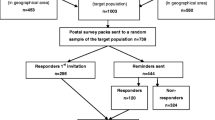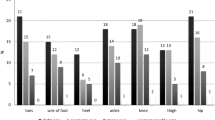Abstract
Foot involvement is a major feature of rheumatoid arthritis (RA). Most epidemiological studies of the RA foot report radiological changes and results of clinical examination. This study aimed to determine the prevalence of foot symptoms, frequency of foot assessment and access to foot care from the perspective of people with RA. A questionnaire was sent to 1,040 people with RA throughout the UK enquiring about foot symptoms, their anatomical distribution (via validated mannequins) availability of podiatry services and perceived usefulness of interventions for alleviating foot symptoms. Altogether 585 useable replies were received; 93.5% of respondents reported having experienced foot pain, and 35.4% reported current foot pain as the presenting symptom. Most (68.2%) reported moderate or severe foot pain daily. Pain was most prevalent in the forefoot and/or ankle. The main predictive factors for reporting current foot pain were longer disease duration (mean 13 vs 10.3 years, p = 0.009), higher BMI (25.6 vs 24.1 p = 0.001) and the prevalent foot symptoms foot stiffness and numbness (both p < 0.0001). Age, gender and current treatment were not significantly associated. Most (82%) had discussed foot symptoms with their rheumatologist, and only 64% had seen a podiatrist. Reported current adherence to prescribed orthoses was 55.8% and to prescribed shoes was 29.5%. Foot symptoms are ubiquitous in RA and frequently severe. Most patients had discussed their symptoms with their rheumatologist, and only 64% had specifically seen a podiatrist. Despite the remarkable progress in development of new treatment modalities for RA, foot pain remains a common and disabling symptom. Our findings support the need for wider access to specific foot care services and evidence-based, patient-centred interventions.

Similar content being viewed by others
References
Vainio K (1956) The rheumatoid foot. Annales Chirurgiae et Gynaecologiae Fenniae 45(Suppl 1):1–107
Matricali GA, Boonen A, Verduyckt J, Taelman V, Verschueren P, Sileghem A, Corluy L, Westhovens R (2006) The presence of forefoot problems and the role of surgery in patients with rheumatoid arthritis. Ann Rheum Dis 65(9):1254–1255
Turner DE, Helliwell PS, Emery P, Woodburn J (2006) The impact of rheumatoid arthritis on foot function in the early stages of disease: a clinical case series. BMC Musculoskeletal Dis 7:102–110
Lohkamp M, Burrow G, McCarron T, Maclaren W, Granat M (2006) The prevalence and anatomical location of foot pain in early diagnosed patients with rheumatoid arthritis. Br J Podiatry 9(4):115–119
Spiegel TM, Spiegel JS (1982) Rheumatoid arthritis in the foot and ankle—diagnosis, pathology and treatment: the relationship between foot and ankle deformity and disease duration in 50 patients. Foot Ankle 2(6):318–324
Michelson J, Easley M, Wigley FM, Hellman D (1994) Foot and ankle problems in rheumatoid arthritis. Foot Ankle 15(11):608–613
Vidigal EC (1978) Forefoot in chronic arthritis. Orthop Rev 7(1):43–46
Shi K, Tomita T, Hayashida K, Owaki H, Ochi T (2000) Foot deformities in rheumatoid arthritis and relevance of disease severity. Foot J Rheumatol 27(1):8–9
Grondal L, Tengstrand B, Nordmark B, Wretenberg P, Stark A (2008) The foot: still the most important reason for walking incapacity in rheumatoid arthritis: distribution of symptomatic joints in 1, 000 RA patients. Acta Orthop 79(2):257–261
Bann CM, Fehnel SE, Gagnon DD (2003) Development and validation of the diabetic foot ulcer scale-short form (DFS-SF). Pharmacoeconomics 21(17):1277–1290
Garrow AP, Papageorgiou AC, Silman AJ et al (2000) Development and validation of a questionnaire to assess disabling foot pain. Pain 85:107–113
Aletaha D (2006) Pooled indicies to measure rheumatoid arthritis activity: a good reflection of the physician’s mind? Arthritis Res Ther 8(1):102
Aletaha D, Machold KP, Nell VP, Smolen JS (2006) The perception of rheumatoid arthritis core set measures by rheumatologists. Results of a survey. Rheumatology (Oxford) 45(9):1133–1139
Prevoo ML, van t’Hof MA, Kuper HH, van Leeuwen MA, van de Putte LB, van Riel PLCM (1995) Modified disease activity scores that indicate twenty-eight-joint counts. Development and validation in a prospective longitudinal study of patients with rheumatoid arthritis. Arthritis Rheum 38(1):44–48
Leeb BF, Andel I, Leder S, Leeb BA, Rintelen B (2005) The patient’s perspective and rheumatoid arthritis disease activity indexes. Rheumatology 44(3):360–365
Landewé R, van der Heijde D, van der Linden S, Boers M (2006) Twenty-eight-joint counts invalidate the DAS 28 remission owing to the omission of the lower extremity joints: a comparison with the original DAS remission. Ann Rheum Dis 65(5):637–641
Katz PP, Morris A, Yelin EH (2006) Prevalence and predictors of disability in valued life activities among individuals with rheumatoid arthritis. Ann Rheum Dis 65(6):763–769
Kavlak Y, Uygur F, Korkmaz C, Bek N (2003) Outcome of orthoses intervention in the rheumatoid foot. Foot Ankle Int 24(6):494–499
Woodburn J, Barker S, Helliwell PS (2002) A randomised controlled trial of foot orthoses in rheumatoid arthritis. J Rheumatol 29(7):1377–1383
Kerry RM, Holt GM Stockley I (1994) The foot in chronic rheumatoid arthritis; a continuing problem. Foot 4:201–203
Donnan PT, MacDonald TM, Morris AD (2002) Adherence to prescribed oral hypoglycaemic medication in a population of patients with Type 2 diabetes: a retrospective cohort study. Diabet Med 19(4):279–284
Benner JS, Glynn RJ, Mogun H, Neumann PJ, Weinstein MC, Avorn J (2002) Long-term persistence in use of statin therapy in elderly patients. J Am Med Assoc 288(4):455–461
Fransen M, Edmonds J (1997) Off-the-shelf orthopaedic footwear for people with rheumatoid arthritis. Arthritis Care Res 10(4):250–256
Williams AE, Rome K, Nester CJ (2007) A clinical trial of specialist footwear for patients with rheumatoid arthritis. Rheumatology (Oxford) 46:302–307
de Magalhaes EP, Davitt M, Filho DJ, Battistella LR, Bertolo MB (2006) The effect of foot orthoses in rheumatoid arthritis. Rheumatology (Oxford) 45:449–453
Egan M, Brosseau L, Farmer M, Ouimet MA, Rees S, Wells G, Tugwell P (2001) Splints and orthoses for treating rheumatoid arthritis. The Cochrane Database of systematic reviews Issue 4 Art, No CD004018. doi:10.1002/14651858.CD004018
Williams AE (2006) Patient perceptions of stock footwear design features. Prosthet Orthot Int 30(1):61–71
Helliwell PS (2003) Lessons to be learned: review of a multi-disciplinary foot clinic in rheumatology. Rheumatology (Oxford) 42(11):1426–1427
Redmond AC, Waxman R, Helliwell PS (2006) Provision of foot health services in rheumatology in the UK. Rheumatology (Oxford) 45(5):571–576
Walker-Bone K, Reading I, Coggon D, Cooper C, Palmer KT (2004) The anatomical pattern and determinants of pain in the neck and upper limbs: an epidemiologic study. Pain 109(1–2):45–51
Jordan KM, Sawyer S, Coakley P, Smith HE, Cooper C, Arden NK (2004) The use of conventional and complementary treatment for knee osteoarthritis in the community. Rheumatology (Oxford) 43(3):381–384
Arthritis and Musculoskeletal Alliance (ARMA) (2004) Standards of care for people with inflammatory arthritis. www.arma.uk.net/pdfs/ia06
National Institute for Health and Clinical Excellence (NICE) 2009 NICE clinical guideline 79—rheumatoid arthritis. www.NICE.org.uk/CG79
Acknowledgements
The authors wish to thank the National Rheumatoid Arthritis Society for their support, those who took the time to complete a questionnaire and the research assistants for their help with running the project.
Disclosures
None.
Author information
Authors and Affiliations
Corresponding author
Appendix
Appendix








Rights and permissions
About this article
Cite this article
Otter, S.J., Lucas, K., Springett, K. et al. Foot pain in rheumatoid arthritis prevalence, risk factors and management: an epidemiological study. Clin Rheumatol 29, 255–271 (2010). https://doi.org/10.1007/s10067-009-1312-y
Received:
Revised:
Accepted:
Published:
Issue Date:
DOI: https://doi.org/10.1007/s10067-009-1312-y




